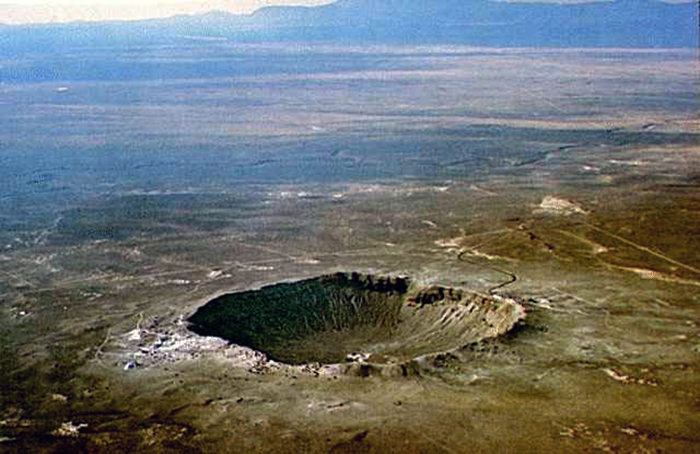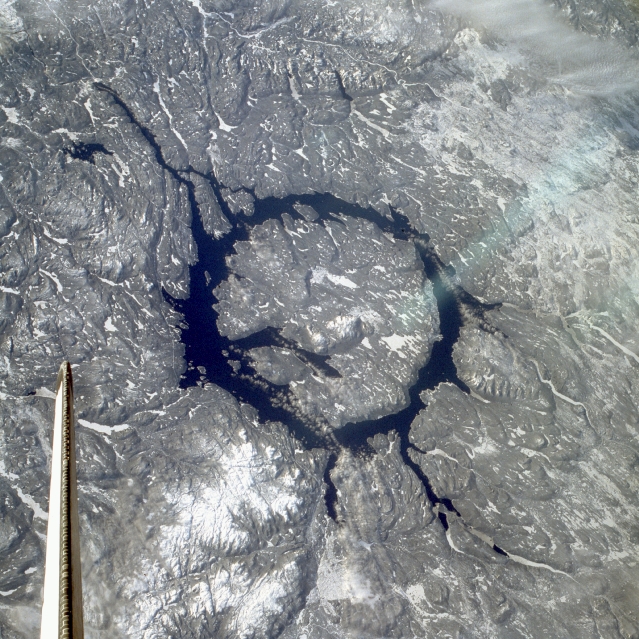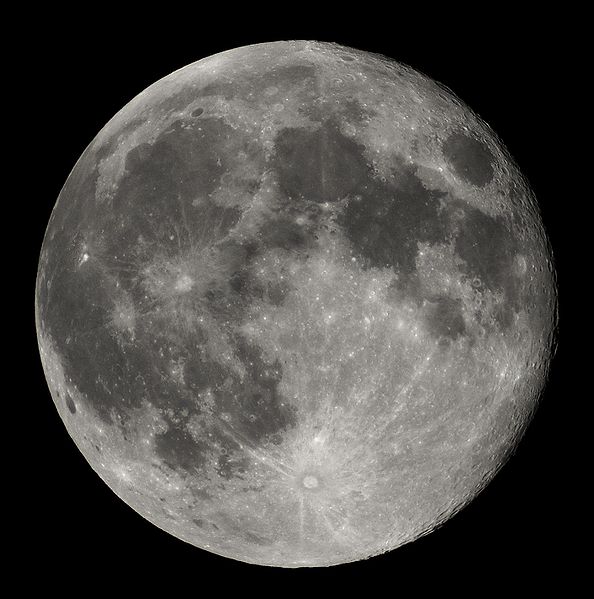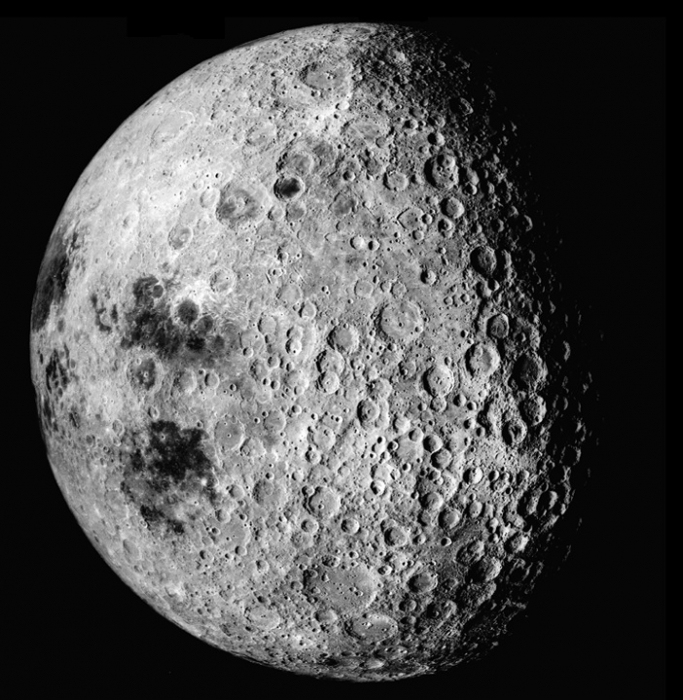Additional reading from www.astronomynotes.com(link is external)
- Atmospheres(link is external)
- Planet Surfaces(link is external)
- Planet Interiors(link is external)
- Earth(link is external)
We are going to begin this lesson with a study of some of the properties of the Earth. We are going to focus on some of the physical processes that occur on Earth, and then we are going to discuss how the other inner planets differ from our observations of the Earth. We will emphasize the interior, the crust, and the atmosphere.
Atmosphere
The Earth has an atmosphere that consists of a mix of various gases (roughly 80% nitrogen and 20% oxygen, with small traces of argon, carbon dioxide, water vapor, and others) that is retained by the Earth's gravity. The Moon has no atmosphere today because its gravitational field is weaker than Earth's, and it wasn't strong enough to retain whatever primordial gases were there originally. The atmosphere helps to regulate the temperature on the Earth, keeping it within a fairly narrow range from day to night. On the Moon, the temperature can vary by 300 degrees during one Moon day — it is hotter than boiling water when the Sun is directly overhead on the Moon and is much colder than water's freezing point on the night side of the Moon.
The temperature on Earth is influenced by the Greenhouse Effect (this name comes from an analogy that isn't perfect, but is close enough for our purposes). This works as follows:
- The Earth absorbs visible light from the Sun.
- The Earth's surface heats up and radiates light in the infrared part of the spectrum.
- Water vapor and carbon dioxide (primarily) in the atmosphere absorb the infrared light from the surface, heating up the atmosphere.
- The atmosphere radiates infrared radiation at the surface of the Earth, also heating it up.
When this process is in equilibrium, the temperature of the Earth varies around a mean temperature from year to year. The discussion about global warming arises from the observation that the increase in carbon dioxide in the atmosphere (mostly due to humans burning fossil fuels) correlates with the steady increase in the mean temperature of the Earth because of an increase in the magnitude of the greenhouse effect.
Apart from the fact that we breathe the gas in the Earth's atmosphere and that the atmosphere keeps the temperature of the Earth warm enough for us to exist, the atmosphere also has played a role in shaping the Earth's surface. We do not see very many craters on the Earth, although there are a few, including "Meteor Crater," or "Barringer Crater," in Arizona.

On the Earth, the atmosphere protects us from the impacts of some objects, but the weather also erodes craters over time, making them no longer visible. Satellite images reveal the existence of some ancient craters on Earth, including Manicouagan Crater.

Try this!
Using the free application "Google Earth(link is external)," you can tour the Meteor Crater and Manicouagan Crater from Google Earth to get a sense of their real scale. Can you find any other craters on Earth using Google Earth? If you want to skip right to the answer, you can see the database of currently identified craters in the "Earth Impact Database(link is external)".
You can compare the Google Earth images of the surface of the Earth to the Google Moon(link is external) images of the surface of the Moon (Note: In the Google Earth application, you can now also bring up the 3D map of the Moon; instructions are available on the Google Moon website). How does the appearance of the Moon's surface differ from Earth's?
The Moon is very different. Since it lacks an atmosphere, most of the impact craters that formed on its surface are still visible today, and they will never erode away like those on Earth.
Crust and Interior
When we discuss the surface and the structure of the planets, we are going to focus on their density, because this property tells us a lot about the composition of the planet. Recall, the density is the mass of an object divided by its volume. If you consider comparing a cube of sugar to a cube of lead that is the same size, you will expect the cube of lead to feel heavier than the cube of sugar. This is because in the same volume (a cube of the same size), the lead will contain more mass than the sugar. The metric system was designed so that one cubic centimeter of water has a mass of 1 gram, so we say that the density of water is 1 gram per cubic centimeter (or equivalently, 1000 kilograms per cubic meter, which is another popular unit of measurement for density). The rocks and metals that we are familiar with are all denser than water. A typical rock has a density of about 3 g / cm3 and a typical metal (say iron) has a density of about 8 g / cm3.
Our measurements of the Earth's mass (from Kepler's Laws) and its volume (from its measured size) tell us that its average density is about 5.5g / cm3 — about half way between rock and iron. By studying data from earthquakes around the world, geologists have determined that the Earth is not uniformly made up of the same material. Instead it is differentiated into different layers. We live on the crust. Below the crust is the mantle, and below the mantle is a core. The crust is about 3 g / cm3 and the inner core is about 12 g / cm3, which suggest the crust is made up mostly of ordinary rock, and the inner core is denser than the metal lead. The mantle is a rocky layer intermediate in density between the crust and the core, and it is semi-fluid, somewhat like the consistency of bubble gum or flexible plastic. The crust of the Earth sits on top of the mantle, and because of convection (a process which occurs in fluids with a temperature difference between different layers — the warmer fluid rises, cools off, and then sinks, creating a flow) in the mantle, the plates that make up the crust are very slowly moving with respect to each other. This process of plate tectonics is the cause of earthquakes, the source of mountains and trenches under the oceans, and is one you will discuss in much more detail in the other courses in this program (e.g., EARTH 501 and EARTH 520). For the purposes of ASTRO 801, you should keep in mind though, that on Earth, plate tectonics is ongoing. We will want to consider if this is true of the other objects in the Solar System as we compare and contrast the planets and moons.
The Moon is very different. The average density is 3.3 g / cm3, but more importantly, there is less variation in the density from core to crust than the Earth. The Moon is not geologically active — there are no volcanoes or plate tectonics on the Moon. Equipment left behind by the astronauts who landed on the Moon has detected Moonquakes, but they are very mild. Interestingly, it looks like the core in the Moon is off center. The crust is about 60 km thick on the near side (facing Earth), but it is 150 km thick on the far side. In 2014, my Penn State colleagues published a new study(link is external) suggesting that this variation in the thickness of the Moon's crust was caused by the very hot, molten Earth heating the Earth-facing side while the far side of the Moon cooled off.
The surface of the Moon shows two very different regions. The dark regions (the Maria) are lowlands that were filled in by molten mantle material (lava) about 3.5 billion years ago. The light colored areas are highlands that are made of the original crust of the Moon. You can tell that the Maria are younger than the light colored regions because they have fewer craters. Originally, there were just as many craters in the Maria region as there are everywhere else, but when the molten rock filled in these regions and solidified, it covered many of them. Because the Moon has no atmosphere, the craters are very well preserved, giving us details on what the number of impacts was like in the early history of the Solar System. In the image below, you can see the Maria have few craters, while the other regions of the Moon are speckled with dark craters.

The far side of the Moon (the half that is never pointed towards Earth) looks very different from the side that we see; there are no Maria. This is attributed to the difference in the crust thickness. Since the far side of the Moon is about twice as thick, Lava was not able to penetrate the crust to fill in the lowlands, solidify, and create Maria.

The current leading theory for the formation of the Moon suggests that it was created in a collision between the proto-Earth and a Mars-sized object. Computer simulations of a collision like this show that the material that breaks off of the proto-Earth should wind up coalescing into a Moon-sized object in orbit around the Earth. The material that created the Moon would have come from the crust and mantle of the proto-Earth, which explains its lower density than the Earth. There is an excellent visualization of this in the video "Cosmic Collisions", which was released by NASA and the American Museum of Natural History. AMNH appears to have removed all of the public links to the video, but the History Channel has a good, similar video(link is external) that includes most of the details in the Cosmic Collisions video.